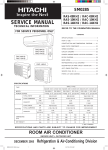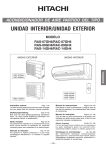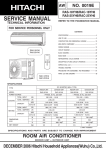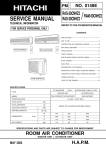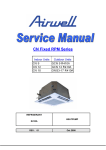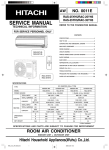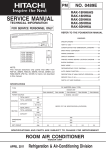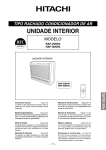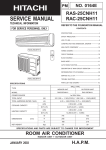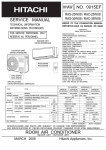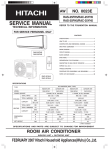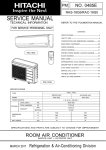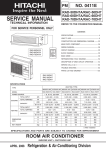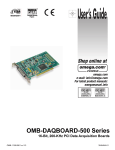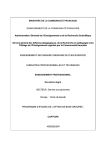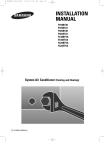Download 1 - Service aer conditionat
Transcript
NO. 0193E PM RAS-07GH4 / RAC-07GH4 RAS-09GH4 / RAC-09GH4 RAS-14GH4 / RAC-14GH4 SERVICE MANUAL TECHNICAL INFORMATION REFER TO THE FOUNDATION MANUAL FOR SERVICE PERSONNEL ONLY CONTENTS SPECIFICATIONS ----------------------------------------------------- 5 HOW TO USE ---------------------------------------------------------- 6 CONSTRUCTION AND DIMENSIONAL DIAGRAM ------- 29 MAIN PARTS COMPONENT ------------------------------------- 31 WIRING DIAGRAM -------------------------------------------------- 33 RAS-07GH4 RAS-09GH4 RAS-14GH4 CIRCUIT DIAGRAM ------------------------------------------------- 35 PRINTED WIRING BOARD LOCATION DIAGRAM ------- 37 RAC-07GH4 RAC-09GH4 BLOCK DIAGRAM --------------------------------------------------- 39 BASIC MODE --------------------------------------------------------- 41 REFRIGERATING CYCLE DIAGRAM ------------------------- 47 RAC-14GH4 DESCRIPTION OF MAIN CIRCUIT OPERATION --------- 49 AUTO SWING FUNCTION ---------------------------------------- 53 SERVICE CALL Q & A -------------------------------------------- 54 PARTS LIST AND DIAGRAM ------------------------------------ 63 SPECIFICATIONS (WALL TYPE) TYPE INDOOR UNIT OUTDOOR UNIT INDOOR UNIT OUTDOOR UNIT INDOOR UNIT OUTDOOR UNIT RAS-07GH4 MODEL POWER SOURCE COOLING RAS-09GH4 RAC-09GH4 RAS-14GH4 RAC-14GH4 TOTAL INPUT (W) 590-610-630 890-900-950 1060-1090-1120 TOTAL AMPERES (A) 2.80-2.80-2.80 4.20-4.10-4.10 5.00-5.00-4.90 (kW) 2.10 2.90 3.50 CAPACITY TOTAL INPUT HEATING RAC-07GH4 1 PHASE, 50 Hz, 220-230-240V 1 PHASE, 50 Hz, 220-230-240V 1 PHASE, 50 Hz, 220-230-240V TOTAL AMPERES CAPACITY DIMENSIONS (mm) NET WEIGHT (B.T.U./h) 7,160 9,900 11,940 (W) 490-510-530 740-770-810 960-1000-1050 (A) 2.30-2.30-2.30 3.50-3.50-3.50 4.60-4.60-4.60 (kW) 2.20 3.00 3.85 (B.T.U./h) 7,500 10,230 13,140 W 780 700 780 700 780 750 H 280 570 280 570 280 570 D 210 210 210 210 210 280 (kg) 9.0 32 9.0 32 9.0 38 After installation SPECIFICATIONS AND PARTS ARE SUBJECT TO CHANGE FOR IMPROVEMENT ROOM AIR CONDITIONER INDOOR UNIT + OUTDOOR UNIT DECEMBER 2003 Refrigeration & Air-Conditioning Division SAFETY DURING REPAIR WORK 1. In order to disassemble and repair the unit in question, be sure to disconnect the power cord plug from the power outlet before starting the work. t nec n o c t dis lug s u p t, I m r cord utlet. s r i o e F pow power e h t the from 2. If it is necessary to replace any parts, they should be replaced with respective genuine parts for the unit, and the replacement must be effected in correct manner according to the instructions in the Service Manual of the unit. If the contacts of electrical parts are defective, replace the electrical parts without trying to repair them. 3. After completion of repairs, the initial state should be restored. 4. Lead wires should be connected and laid as in the initial state. 5. Modification of the unit by user himself should absolutely be prohibited. 6. Tools and measuring instruments for use in repairs or inspection should be accurately calibrated in advance. 7. In installing the unit having been repaired, be careful to prevent the occurence of any accident such as electrical shock, leak of current, or bodily injury due to the drop of any part. 8. To check the insulation of the unit, measure the insulation resistance between the power cord plug and grounding terminal of the unit. The insulation resistance should be 1MΩ or more as measured by a 500V DC megger. 9. The initial location of installation such as window, floor or the other should be checked for being and safe enough to support the repaired unit again. If it is found not so strong and safe, the unit should be installed at the initial location reinforced or at a new location. 10. Any inflammable thing should never be placed about the location of installation. DANGER 11. Check the grounding to see whether it is proper or not, and if it is found improper, connect the grounding terminal to the earth. – 1 – WORKING STANDARDS FOR PREVENTING BREAKAGE OF SEMICONDUCTORS 1. Scope The standards provide for items to be generally observed in carrying and handling semiconductors in relative manufacturers during maintenance and handling thereof. (They apply the same to handling of abnormal goods such as rejected goods being returned). 2. Object parts (1) (2) (3) (4) Micro computer Integrated circuits (IC) Field-effect transistors (FET) P.C. boards or the like on which the parts mentioned in (1) and (2) of this paragraph are equipped. 3. Items to be observed in handling (1) Use a conductive container for carrying and storing of parts. (Even rejected goods should be handled in the same way). IC A conductive polyvinyl bag Conductive sponge IC Fig. 1. Conductive Container (2) When any part is handled uncovered (in counting, packing and the like), the handling person must always use himself as a body earth. (Make yourself a body earth by passing one M ohm earth resistance through a ring or bracelet). (3) Be careful not to touch the parts with your clothing when you hold a part even if a body earth is being taken. (4) Be sure to place a part on a metal plate with grounding. (5) Be careful not to fail to turn off power when you repair the printed circuit board. At the same time, try to repair the printed circuit board on a grounded metal plate. Body earth (Elimik conductive band) Clip for connection with a grounding wire 1M Fig. 2. Body Earth – 2 – (6) Use a three wire type soldering iron including a grounding wire. Metal plate (of aluminium, stainless steel, etc.) Working table Resistor of 1 M (1/2W) Staple Earth wire Bare copper wire (for body earth) Fig. 3. Grounding of the working table Soldering iron Grounding wire Screw stop at the screwed part using a rag plate Fig. 4. Grounding a soldering iron Use a high insulation mode (100V, 10M or higher) when ordinary iron is to be used. (7) In checking circuits for maintenance, inspection or some others, be careful not to have the test probes of the measuring instrument shortcircuit a load circuit or the like. – 3 – ! CAUTION 1. In quiet or stopping operation, slight flowing noise of refrigerant in the refrigerating cycle is heard occasionally, but this noise is not abnormal for the operation. 2. When it thunders near by, it is recommended to stop the operation and to disconnect the power cord plug from the power outlet for safety. 3. In the event of power failure, the airconditioner will restart automatically in the previously selected mode once the power is restored. In the event of power failure during TIMER operation, the timer will be reset and the unit will begin or stop operating under a new timer setting. 4. If the room air conditioner is stopped by adjusting thermostat, or missoperation, and re-start in a moment, there is occasion that the cooling and heating operation does not start for 3 minutes, it is not abnormal and this is the result of the operation of IC delay circuit. This IC delay circuit ensures that there is no danger of blowing fuse or damaging parts even if operation is restarted accidentally. 5. This room air conditioner should not be used at the cooling operation when the outside temperature is below 10°C (50°F). 6. This room air conditioner (the reverse cycle) should not be used when the outside temperature is below –10°C (14°F). If the reverse cycle is used under this condition, the outside heat exchanger is frosted and efficiency falls. 7. When the outside heat exchanger is frosted, the frost is melted by operating the hot gas system, it is not trouble that at this time fan stops and the vapour may rise from the outside heat exchanger. – 4 – SPECIFICATIONS RAS-07GH4 RAS-09GH4 RAC-07GH4 RAC-09GH4 RAC-14GH4 RAS-14GH4 MODEL 20 W 20 W 30 W FAN MOTOR CAPACITOR NO 1.5μF, 450 VAC 2.5μF, 450VAC FAN MOTOR PROTECTOR NO FAN MOTOR NO – 5RS080 COMPRESSOR MOTOR CAPACITOR NO 20μF, 450 VAC OVERLOAD PROTECTOR NO YES OVERHEAT PROTECTOR NO NO FUSE (for MICROPROCESSOR) 3.15A NO POWER RELAY G4A NO POWER SWITCH YES NO TEMPORARY SWITCH YES NO SERVICE SWITCH YES NO TRANSFORMER NO NO VARISTOR 450NR NO FUSE CAPACITY (TIME DELAY FUSE) --------- COMPRESSOR THERMOSTAT REMOTE CONTROL SWITCH (LIQUID CRYSTAL) REFRIGERANT CHARGING VOLUME (Refrigerant 410A) 10 A 15 A NO YES NO --------- MAX. PIPES --------- WITHOUT REFRIGERANT BECAUSE COUPLING IS FLARE TYPE 600g 650g 10m 5RS132 25μF, 450 VAC YES(IC) UNIT – 5 – 5RS112 1050g 15m MODEL RAS-07GH4 / RAC-07GH4 and RAS-09GH4 / RAC-09GH4 Figure showing the installation of Indoor anf Outdoor unit ! The installation height of indoor unit must be 2.3m or more in a non public area CAUTION above 50mm 2 1 above 100mm 2,300mm or more Minimum pipe length 5m Maximum pipe length 10m above 300mm above must not bend 0.45m above 100mm Plug above 200mm above 50mm when installed on the ceiling of balcony ● ❈ above 100mm ❈ give clearance as wide as possible above 100mm ❈ above 300mm The indoor piping should be insulated with the enclosed insulation pipe. (If the insulator is insufficient, please use commersial products). ● The difference in height between the indoor and outdoor unit should be kept max 5m. The connecting pipe, no matter big or small, should all be insulated with insulation pipe and then wrapped with vinyl tape. (The insulator will deteriorate if it is not wrapped with tape). The connection of insulated drain hose. above 200mm inner diameter ø 16mm Please use insulated drain hose for the indoor piping (commercial product). –– 5a 6 –– MODEL RAS-14GH4 / RAC-14GH4 Figure showing the installation of Indoor anf Outdoor unit ! The installation height of indoor unit must be 2.3m or more in a non public area CAUTION above 50mm 2 1 above must not bend 0.45m above 100mm 2,300mm or more Minimum pipe length 5m Maximum pipe length 15m above 300mm above 100mm Plug ● above 200mm ( above 50mm when installed on the ceiling of balcony ) The indoor piping should be insulated with the enclosed insulation pipe. (If the insulator is insufficient, please use commersial products). above 100mm give clearance as wide as possible above 100mm ● The difference in height between the indoor and outdoor unit should be kept max 5m. The connecting pipe, no matter big or small, should all be insulated with insulation pipe and then wrapped with vinyl tape. (The insulator will deteriorate if it is not wrapped with tape). above 200mm The connection of insulated drain hose. above 700mm inner diameter ø 16mm Please use insulated drain hose for the indoor piping (commercial product). –– 5b 7 –– SAFETY PRECAUTION ● ● ● Please read the “Safety Precaution” carefully before operating the unit to ensure correct usage of the unit. Pay special attention to signs of “ ! Warning” and “ ! Caution”. The “Warning” section contains matters which, if not observed strictly, may cause death or serious injury. The “Caution” section contains matters which may result in serious consequences if not observed properly. Please observe all instructions strictly to ensure safety. The sign indicate the following meanings. The sign in the figure indicates prohibition. Make sure to connect earth line. Indicates the instructions that must be followed. ● Please keep this manual after reading. PRECAUTIONS DURING INSTALLATION ! ● Do not reconstruct the unit. Water leakage, fault, short circuit or fire may occur if you reconstruct the unit by yourself. ● Please ask your sales agent or qualified technician for the installation of your unit. Water leakage, short circuit or fire may occur if you install the unit by yourself. ● Please use earth line. Do not place the earth line near water or gas pipes, lightning-conductor, or the earth line of telephone. Improper installation of earth line may cause electric shock. ● A circuit breaker should be installed depending on the mounting site of the unit. Without a circuit breaker, the danger of electric shock exists. ● Do not install the unit near a location where there is flammable gas. The outdoor unit may catch fire if flammable gas leaks around it. ● Please ensure smooth flow of water when installing the drain hose. WARNING ! CAUTION PRECAUTIONS DURING SHIFTING OR MAINTENANCE ! W A R N I N G ● Should abnormal situation arises (like burning smell), please stop operating the unit and turn off the circuit breaker. Contact your agent. Fault, short circuit or fire may occur if you continue to operate the unit under abnormal situation. ● Please contact your agent for maintenance. Improper self maintenance may cause electric shock and fire. ● Please contact your agent if you need to remove and reinstall the unit. Electric shock or fire may occur if you remove and reinstall the unit yourself improperly. PRECAUTIONS DURING OPERATION ! W A R N I N G ● Avoid an extended period of direct air flow for your health. ● ● Do not insert a finger, a rod or other objects into the air outlet or inlet. As the fan is rotating at a high speed, it will cause injury. Before cleaning, be sure to stop the operation and turn the breaker OFF. Do not use any conductor as fuse wire, this could cause fatal accident. ● During thunder storm, disconnect and turn off the circuit breaker. – 6 – PRECAUTIONS DURING OPERATION ● The product shall be operated under the manufacturer specification and not for any other intended use. ● ● When operating the unit with burning equipments, regularly ventilate the room to avoid oxygen insufficiency. ● ● ● C A U T I O N Please switch off the unit and turn off the circuit breaker during cleaning, the high-speed fan inside the unit may cause danger. Turn off the circuit breaker if the unit is not to be operated for a long period. ● ● Do not splash or direct water to the body of the unit when cleaning it as this may cause short circuit. Do not use any aerosol or hair sprays near the indoor unit. This chemical can adhere on heat exchanger fin and blocked the evaporation water flow to drain pan. The water will drop on tangential fan and cause water splashing out from indoor unit. ● ● Do not direct the cool air coming out from the air-conditioner panel to face household heating apparatus as this may affect the working of apparatus such as the electric kettle, oven etc. Please ensure that outdoor mounting frame is always stable, firm and without defect. If not, the outdoor unit may collapse and cause danger. ● ! Do not attempt to operate the unit with wet hands, this could cause fatal accident. Do not climb on the outdoor unit or put objects on it. Do not put water container (like vase) on the indoor unit to avoid water dripping into the unit. Dripping water will damage the insulator inside the unit and causes short-circuit. ● Do not place plants directly under the air flow as it is bad for the plants. When operating the unit with the door and windows opened, (the room humidity is always above 80%) and with the air deflector facing down or moving automatically for a long period of time, water will condense on the air deflector and drips down occasionally. This will wet your furniture. Therefore, do not operate under such condition for a long time. ● If the amount of heat in the room is above the cooling or heating capability of the unit (for example: more people entering the room, using heating equipments and etc.), the preset room temperature cannot be achieved. ● – 7 – NAMES AND FUNCTIONS OF EACH PART INDOOR UNIT Air filter To prevent dust from coming into the indoor unit. (Refer page 25) Front panel Indoor unit indicators Light indicator showing the operating condition. (Refer page 9) Horizontal deflector (Air Outlet) (Refer page 20) ● Vertical deflector Remote controller Send out operation signal to the indoor unit. So as to operate the whole unit. (Refer page 10) OUTDOOR UNIT RAC-07GH4 RAC-09GH4 Drain pipe Condensed water drain to outside. Connecting cord and insulation pipe for piping Air inlet (Back, Left side) Air outlet RAC-14GH4 Drain pipe Condensed water drain to outside. Connecting cord and insulation pipe for piping Air inlet (Back and Left side) Air outlet ! CAUTION • When heating operation, drain or defrosted water flows out from outdoor unit. Don’t close drain outlet portion in chilly area so as not to freeze these. MODEL NAME AND DIMENSIONS MODEL WIDTH (mm) HEIGHT (mm) DEPTH (mm) RAS-07GH4/09GH4/14GH4 780 280 210 RAC-07GH4/09GH4 700 570 210 RAC-14GH4 750 570 280 – 8 – INDOOR UNIT INDICATORS FILTER LAMP When the device is operated for a total of about 100 hours, the FILTER lamp lights to indicate that it is time to clean the filter. The lamp goes out when the POWER SWITCH set to OFF and ON again. OPERATION LAMP This lamp lights during operation. The OPERATION LAMP flashes in the following cases during heating. (1) During preheating For about 2–3 minutes after starting up. (2) During defrosting Defrosting will be performed about once every one hour when frost forms on the heat exchanger of the outdoor unit, for 5–10 minutes each time. TEMPORARY SWITCH TIMER LAMP This lamp lights when the timer is working. OPERATION INDICATOR Temporary Switch TEMPORARY SWITCH Press Non-conductor Stick TEMPORARY SWITCH Use this switch to start and stop when the remote controller does not work. [Use non-conductor stick (example toothpick)] ● By pressing the temporary switch, the operation is done in previously set operation mode. ● When the operation is done using the temporary switch after the power source is turned off and turn on again, the operation is done in automatic mode. – 9 – NAMES AND FUNCTIONS OF REMOTE CONTROL UNIT REMOTE CONTROLLER ● This controls the operation of the indoor unit. The range of control is about 7 meters. If indoor lighting is controlled electronically, the range of control may be shorter. This unit can be fixed on a wall using the fixture provided. Before fixing it, make sure the indoor unit can be controlled from the remote controller. ● Handle the remote controller with care. Dropping it or getting it wet may compromise its signal transmission capability. ● After new batteries are inserted into the remote controller, the unit will initially require approximately 10 seconds to respond to commands and operate. ˚CH ˚CH RESET AUTO ● Signal emitting window/transmission sign Point this window toward the indoor unit when controlling it. The transmission sign blinks when a signal is sent. ● Display This indicates the room temperature selected, current time, timer status, function and intensity of circulation selected. ● START/STOP button Press this button to start operation. Press it again to stop operation. ● SLEEP button Use this button to set the sleep timer. ● TEMPERATURE buttons Use these buttons to raise or lower the temperature setting. (Keep pressed, and the value will change more quickly.) ● TIME button Use this button to set and check the time and date. ● RESET buttons ● FUNCTION selector Use this button to select the operating mode. Every time you press it, the mode will change from (AUTO) to (HEAT) to (DEHUMIDIFY) to (COOL) and to (FAN) cyclically. ● FAN SPEED selector This determines the fan speed. Every time you press this button, the intensity of circulation will change from (AUTO) to (HI) to (MED) to (LOW) (during the (FAN) mode, from HI to MED to LOW). ● AUTO SWING button Controls the angle of the horizontal air deflector. ● TIMER control Use this button to set the timer. ● OFF-TIMER button Select the turn OFF time. ● ON-TIMER button Select the turn ON time. ● RESERVE button Time setting reservation. ● CANCEL button Cancel time reservation. HEAT DEHUMIDIFY COOL FAN FAN SPEED LOW MED HI SLEEPING STOP (CANCEL) START (RESERVE) START/STOP TIME TIMER SET TIMER SELECTOR ON TIMER OFF TIMER AUTO SWING Precautions for Use ● Do not put the remote controller in the following places. ● Under direct sunlight. ● In the vicinity of a heater. ● Handle the remote controller carefully. Do not drop it on the floor, and protect it from water. ● Once the outdoor unit stops, it will not restart for about 3 minutes (unless you turn the power switch off and on or unplug the power cord and plug it in again). This is to protect the device and does not indicate a failure. ● If you press the FUNCTION selector button during operation, the device may stop for about 3 minutes for protection. – 10 – AUTOMATIC OPERATION The device will automatically determine the mode of operation, HEAT, COOL or DEHUMIDIFY depending on the initial room temperature. The selected mode of operation will not change when the room temperature varies. Press the FUNCTION selector so that the display indicates the mode of operation. 1 ● START STOP RESET (AUTO) When AUTO has been selected, the device will automatically determine the mode of operation, HEAT, COOL or DEHUMIDIFY depending on the initial room temperature. Press the (START/STOP) button. Operation starts with a beep. Press the button again to stop operation. ■ As the settings are stored in memory in the remote controller, you only have to press the (START/STOP) button next time. You can raise or lower the temperature setting as necessary by maximum of 3°C. Press the temperature button and the temperature setting will change by 1°C each time. °C ● ● The preset temperature and the actual room temperature may vary somewhat depending on conditions. The display does not indicate the preset temperature in the AUTO mode. If you change the setting, the indoor unit will produce a beep. ■ Condition of Automatic Operation Initial room temperature (approx.) 23~27°C Under 23°C - - - Over 27°C Function Temperature setting FAN SPEED COOL 27°C HI at start, MED or LOW after the preset temperature is reached DEHUMIDIFY Slightly lower than the room temperature LOW HEAT 23°C HI at start, MED or LOW after the preset temperature is reached – 11 – HEATING OPERATION ● ● Use the device for heating when the outdoor temperature is under 21°C. When it is too warm (over 24°C), the heating function may not work in order to protect the device. In order to keep reliability of the device, please use this device above –10°C of the outdoor temperature. ˚C 1 2 RESET Press the FUNCTION selector so that the display indicates (HEAT). Set the desired FAN SPEED with the (FAN SPEED) button (the display indicates the setting). (AUTO): The fan speed is HI at first and varies to MED automatically when the preset temperature has been reached. (HI) : Economical as the room will become warm quickly. But you may feel a chill at the beginning. (MED) : Quiet. (LOW) : More quiet. Set the desired room temperature with the TEMPERATURE buttons (the display indicates the setting). 3 ˚C The range of 18-22°C is recommended as the room temperature for heating. If the temperature setting is 20°C, the room temperature will be controlled at around 20°C. The temperature setting and the actual room temperature may vary somewhat depending on conditions. (START/STOP) button. Heating operation starts START Press the STOP with a beep. Press the button again to stop operation. ■ As the settings are stored in memory in the remote controller, you only have to press the (START/STOP) button next time. – 12 – DEHUMIDIFYING OPERATION Use the device for dehumidifying when the room temperature is over 16°C. When it is under 15°C, the dehumidifying function will not work. 1 ˚C Press the FUNCTION selector so that the display indicates (DEHUMIDIFY). The FAN SPEED is set at LOW automatically. The FAN SPEED button does not work. Set the desired room temperature with the TEMPERATURE button (the display indicates the setting). 2 RESET The range of 20-26˚C is recommended as the room temperature for dehumidifying. START Press the (START/STOP) button. Dehumidifying operation STOP starts with a beep. Press the button again to stop operation. ■ As the settings are stored in memory in the remote controller, you (START/STOP) button next time. only have to press the ˚C ■ Dehumidifying Function When the room temperature is higher than the temperature setting: The device will dehumidify the room, reducing the room temperature to the preset level. When the room temperature is lower than the temperature setting: Dehumidifying will be performed at the temperature setting slightly lower than the current room temperature, regardless of the temperature setting. The function will stop (the indoor unit will stop emitting air) as soon as the room temperature becomes lower than the setting temperature. – 13 – COOLING OPERATION Use the device for cooling when the outdoor temperature is 22-42°C. If indoor humidity is very high (over 80%), some dew may form on the air outlet grille of the indoor unit. ˚C 1 Press the FUNCTION selector so that the display indicates (COOL). Set the desired FAN SPEED with the (the display indicates the setting). RESET 2 (FAN SPEED) button (AUTO): The FAN SPEED is HI at first and varies to MED automatically when the preset temperature has been reached. (HI) : Economical as the room will become cool quickly. (MED) : Quiet. (LOW) : More quiet. Set the desired room temperature with the TEMPERATURE button (the display indicates the setting). ˚C 3 The range of 25-28°C is recommended as the room temperature for cooling. If the temperature setting is 27°C, the room temperature will be controlled at around 27°C. The temperature setting and the actual room temperature may vary some how depending on conditions. (START/STOP) button. Cooling operation starts Press the with a beep. Press the button again to stop operation. The cooling function does not start if the temperature setting is START higher than the current room temperature (even though the STOP (OPERATION) lamp lights). The cooling function will start as soon as you set the temperature below the current room temperature. ■ As the settings are stored in memory in the remote controller, you (START/STOP) button next time. only have to press the – 14 – FAN OPERATION You can use the device simply as an air circulator. Use this function to dry the interior of the indoor unit at the end of summer. 1 2 RESET FAN SPEED (AUTO) START STOP ● ● ● For the cooling operation Press the (FAN SPEED) button. Press the (START/STOP) button. Fan operation starts with a beep. Press the button again to stop operation. ..... When the AUTO fan speed mode is set in the cooling/heating operation: ● For the heating operation Press the FUNCTION selector so that the display indicates (FAN). ● The fan speed will automatically change according to the temperature of discharged air. When the difference of room temperature and setting temperature is large, fan starts to run at HI speed. When the room temperature reaches setting temperature, fan speed changes to LOW automatically. When the difference of room temperature and setting temperature is large, fan starts to run at HI speed. After room temperature reaches the preset temperature, the cooling operation, which changes the fan speed and room temperature to obtain optimum conditions for natural healthful cooling will be performed. – 15 – HOW TO SET THE TIMER 1 Time, Day, Month TIME, DAY, MONTH (current time, day, month) Set the current month and day with the TIMER control button. After you change the batteries; M D M D OFF TIMER RESET ON TIMER 1 OFF-Timer Press the (OFF-TIMER) button. The (OFF) mark blinks on the display. RESERVE CANCEL Start AM STOP You can set the device to turn off at the present time. ON-Timer Stop ● Start The device will turn on at the designated times. 1 Press the (ON-TIMER) button the (ON) mark blinks on the display. AM 1 ON/OFF-Timer Start Stop Press the (ON-OFF) button so that the (OFF) mark blinks. ● The device will turn on (off) and off (on) at the designated times. ● The switching occurs first at the preset time that comes earlier. ● The arrow mark appearing on the display indicates the sequence of switching operations. 2 Set the turn-off time with the TIMER control button. Press the (RESERVE) button. 3 Press the (ONTIMER) button so that the (OFF) mark lights and the (ON) mark blinks. PM PM PM AM How to Cancel Reservation Point the signal window of the remote controller toward the indoor unit, and press the (CANCEL) button. The (RESERVED) sign goes out with a beep and the (TIMER) lamp turns off on the indoor unit. NOTE You can set only one of the OFF-timer, ON-timer and ON/OFF-timer. – 16 – 3 2 4 Set the current time with the TIMER control button. Press the (TIME) button. Press the (TIME) button again. The time indication starts lighting instead of flashing. ● The time indication will disappear automatically in 10 second. PM AM PM ● To check the current time setting, PM press the The setting of the current time is now complete. Example: The current time is 1:30 p.m. 2 Set the turn-off time with the TIMER control button. PM (TIME) button twice. 3 Point the signal window of the remote controller toward the indoor unit, and press the (RESERVE) button. The (OFF) mark starts lighting instead of flashing and the sign (RESERVED) lights. A beep occurs and the (TIMER) lamp lights on the indoor unit. PM Example: The device will turn off at 11:00p.m. The setting of turn-off time is now complete. 2 Set the turn-on time with the TIMER control button. 3 Point the signal window of the remote controller toward the indoor unit, and press the (RESERVE) button. The (ON) mark starts lighting instead of flashing and the (RESERVED) sign lights. A beep occurs and the (TIMER) lamp lights on the indoor unit. AM 4 Set the turn-on time with the TIMER control button. AM Example: The device will automatically turn on earlier so that the preset temperature can be reached at 7:00 a.m. The setting of the turn-on time is now complete. 5 Point the signal window of the remote controller toward the indoor unit, and press the (RESERVE) button. The (ON) mark starts lighting instead of flashing and the (RESERVED) sign lights. A beep occurs and the (TIMER) lamp lights on the indoor unit. PM PM AM AM Example: The device will turn off at 10:30 p.m. and then automatically turn on earlier so that the preset temperature can be reached at 7:00 a.m. The settings of the turn-on/off times are now complete. ● The timer may be used in three ways: off-timer, on-timer, and ON/OFF (OFF/ON)-timer. Set the current time at first because it serves as a reference. ● As the time settings are stored in memory in the remote controller, you only have to press the (RESERVE) button in order to use the same settings next time. – 17 – HOW TO SET THE SLEEP TIMER Set the current time at first if it is not set before (see the pages for setting the current time). Press the (SLEEP) button, and the display changes as shown below. Mode Indication 41 Sleep timer H SLEEP hour 42 hours 4 3 hours Sleep timer off 1 47 hours Sleep Timer: The device will continue working for the designated number of hours and then turn off. Point the signal window of the remote controller toward the indoor unit, and press the SLEEP button. The timer information will be displayed on the remote controller. The TIMER lamp lights with a beep from the indoor unit. When the sleep timer has been set, the display indicates the turn-off time. Example: If you set 3 hours sleep time at 11:38 p.m., the turn-off time is 2:38 a.m. H Sleep timer Start The device will be turned off by the sleep timer and turned on by on-timer. 1 Set the ON-timer. 2 Press the (SLEEP) button and set the sleep timer. AM H AM Example: In this case, the device will turn off in 2 hours (at 1:38 a.m.) and turn on early so that the preset temperature will be almost reached at 6:00 next morning. How to Cancel Reservation Point the signal window of the remote controller toward the indoor unit, and press the (CANCEL) button. The (RESERVED) sign goes out with a beep and the (TIMER) lamp turns off on the indoor unit. – 18 – Explanation of the sleep timer The device will control the FAN SPEED and room temperature automatically so as to be quiet and good for people’s health. You can set the sleep timer to turn off after 1, 2, 3 or 7 hours. The FAN SPEED and room temperature will be controlled as shown below. Operation with the sleep timer Function Heating “ ” Cooling “ ” and dehumidifying “ Operation The room temperature will be controlled 5°C below the temperature and the FAN SPEED will be set to LOW setting 60 minutes after the setting of the sleep timer. The room temperature will be controlled 2°C above the temperature and the FAN SPEED will be set to LOW setting 60 minutes after the setting of the sleep timer. “ Sleep timer set 6 hours later 7 hours later 2 hours later 60 minutes later ” Fan 2°C 3 hours later The settings of room temperature and circulation are varied. ” NOTE ● ● ● ● ● If date or current time is not set, sleep timer can not be set. If you set the sleep timer after the off-, on/off- or off/on-timer has been set, the sleep timer becomes effective instead of the off-, on/off- or off/on-timer set earlier. You can not set other timer during sleep timer operation. After sleep timer time is up and when press sleep button again, the sleep timer will be set as last setting. Sleep timer effective only once. – 19 – ADJUSTING THE AIR DEFLECTOR 1 Adjustment of the conditioned air in the upward and downward directions. The horizontal air deflector is automatically set to the proper angle suitable for each operation. The deflector can be swung up and down continuously and also set to the desired angle using the “ (AUTO SWING)” button. RESET ● If the “ (AUTO SWING)” button is pressed once, the horizontal air deflector swings up and down. If the button is pressed again, the deflector stops in its current position. Several seconds (about 6 seconds) may be required before the deflector starts to move. ● Use the horizontal air deflector within the adjusting range shown on the right. When cooling, dehumidifying ● When the operation is stopped, the horizontal air deflector moves and stops at the position where the air outlet closes. Vertical about 15 about 60 ! CAUTION ● In “Cooling” operation, do not keep the horizontal air deflector swinging for a long time. Some dew may form on the horizontal air deflector and dew may drop. When heating Vertical 2 Adjustment of the conditioned air to the left and right. Hold the vertical air deflector as shown in the figure and adjust the conditioned air to the left and right. about 45 about 30 ! CAUTION When operating the unit in cooling operation with the air deflector facing down and moving automatically for a long period of time, water will condensed on the air deflector and drips down occasionally. This will wet your furniture. – 20 – HOW TO EXCHANGE THE BATTERIES IN THE REMOTE CONTROLLER 1 Remove the cover as shown in the figure and take out the old batteries. = 2 Install the new batteries. The direction of the batteries should match the marks in the case. ! CAUTION 1. Do not use new and old batteries, or different kinds of batteries together. 2. Take out the batteries when you do not use the remote controller for 2 or 3 months. – 21 – Push and pull to the direction of arrow THE IDEAL WAYS OF OPERATION Suitable Room Temperature Install curtain or blinds ! Warning It is possible to reduce heat entering the room through windows. Freezing temperature is bad for health and a waste of electric power. Ventilation Effective Usage Of Timer At night, please use the “OFF or ON timer operation mode”, together with your wake up time in the morning. This will enable you to enjoy a comfortable room temperature. Please use the timer effectively. ! Caution Do not close the room for a long period of time. Occasionally open the door and windows to allow the entrance of fresh air. Do Not Forget To Clean The Air Filter Dusty air filter will reduce the air volume and the cooling efficiency. To prevent from wasting electric energy, please clean the filter every 2 weeks. Please Adjust Suitable Temperature For Baby And Children Please pay attention to the room temperature and air flow direction when operating the unit for baby, children and old folks who have difficulty in movement. – 22 – FOR USER’S INFORMATION The Air Conditioner And The Heat Source In The Room ! Caution If the amount of heat in the room is above the cooling capability of the air conditioner (for example: more people entering the room, using heating equipments and etc.), the preset room temperature cannot be achieved. Not Operating For A Long Time When the indoor unit is not to be used for a long period of time, please switch off the power from the mains. If the power from mains remains “ON”, the indoor unit still consumes about 8W in the operation control circuit even if it is in “OFF” mode. OFF When Lightning Occurs ! Warning To protect the whole unit during lightning, please stop operating the unit and remove the plug from the socket. Interference From Electrical Products ! Caution To avoid noise interference, please place the indoor unit and its remote controller at least 1m away from electrical products. – 23 – Inverter-type fluorescent lamp. To prevent interference, place at least 1m away. TV ATTACHING THE AIR CLEANSING AND DEODORIZING FILTERS ! CAUTION Cleaning and maintenance must be carried out only by qualified service personal. Before cleaning, stop operation and switch off the power supply. 1 Open the front panel. ● Pull up the front panel by holding it at both sides with both hands. 2 Remove the filter. ● Push upward to release the claws and pull out the filter. 3 Attaching the air cleansing and deodorizing filters to the filter. ● Attach the air cleansing and deodorizing filters to the frame by gently compress its both sides and release after insertion into filter frame. ! CAUTION Do not bend the air cleansing and deodorizing filter as it may cause damage to the structure. 4 Attach the filters. ● Attach the filters by ensuring that the surface written “FRONT” is facing front. ● After attaching the filters, push the front panel at three arrow portion as shown in figure and close it. NOTE ● ● ● ● In case of removing the air cleansing and deodorizing filters, please follow the above procedures. The cooling capacity is slightly weakened and the cooling speed becomes slower when the air cleansing and deodorizing filters are used. So, set the fan speed to "HIGH" when using it in this condition. Air cleansing and deodorizing filters are washable and reusable up to 20 times by using vacuum cleaner or water rinse under running tap water. Type number for this air cleansing filter is <SPX-CFH11>. Please use this number for ordering when you want to renew it. Do not operate the air conditioner without filter. Dust may enter the air conditioner and fault may occur. – 24 – MAINTENANCE ! CAUTION Cleaning and maintenance must be carried out only by qualified service personal. Before cleaning, stop operation and switch off the power supply. 1. AIR FILTER Clean the air filter, as it removes dust inside the room. In case the air filter is full of dust, the air flow will decrease and the cooling capacity will be reduced. Further, noise may occur. Be sure to clean the filter following the procedure below. PROCEDURE 1 Open the front panel and remove the filter ● Gently lift and remove the air cleansing and deodorizing filter from the air filter frame. 2 Vacuum dust from the air filter and air cleansing and deodorizing filter using vacuum cleaner. If there is too much dust, rinse under running tap water and gently brush it with soft bristle brush. Allow filters to dry in shade. 3 ● ● Re-insert the air cleansing and deodorizing filter to the filter frame. Set the filter with “FRONT” mark facing front, and slot them into the original state. After attaching the filters, push the front panel at three arrow portions as shown in figure and close it. NOTE: ● Air cleansing and deodorizing filter should be cleaned every month or sooner if noticeable loading occurs. When used overtime, it may loose its deodorizing function. For maximum performance, it is recommended to replace it every 3-6 months depending on application requirements. ! CAUTION ● ● ● Do not wash with hot water at more than 40°C. The filter may shrink. When washing it, shake off moisture completely and dry it in the shade; do not expose it directly to the sun. The filter may shrink. Do not use detergent on the air cleansing and deodorizing filter as some detergent may deteriorate the filter electrostatic performance. – 25 – 2. Washable Front Panel ● Remove the front panel and wash with clean water. Wash it with a soft sponge. After using neutral detergent, wash thoroughly with clean water. ● When front panel is not removed, wipe it with a soft dry cloth. Wipe the remote controller thoroughly with a soft dry cloth. ● Wipe the water thoroughly. If water remains at indicators or signal receiver of indoor unit, it causes trouble. Method of removing the front panel. Be sure to hold the front panel with both hands to detach and attach it. Removing the Front Panel Attaching the Front Panel Flange Hole ● When the front panel is fully opened with both hands, push the right arm to the inside to release it, and while closing the front panel slightly, put it out forward. ● Move the projections of the left and right arms into the Flanges in the unit and securely insert them into the holes. ! CAUTION ● ● Do not splash or direct water to the body of the unit when cleaning it as this may cause short circuit. Never use hot water (above 40°C), benzine, gasoline, acid, thinner or a brush, because they will damage the plastic surface and the coating. 3. Projection MAINTENANCE AT BEGINNING OF LONG OFF PERIOD ● Run the unit by setting the operation mode to (FAN) and the fan speed to HI for about half a day on a fine day, and dry the whole of the unit. ● Switch off the power plug. Air Blow – 26 – ! CAUTION ● Please use earth line. Do not place the earth line near water or gas pipes, lightning-conductor, or the earth line of telephone. Improper installation of earth line may cause electric shock. ● A circuit breaker should be installed depending on the mounting site of the unit. Without a circuit breaker, the danger of electric shock exists. IMPORTANT The wires in this mains lead are coloured in accordance with the following code: Green-and-yellow : Earth Blue : Neutral Brown : Live As the colours of the wires in the mains lead of this appliance may not correspond with the coloured markings identifying the terminals in your plug, proceed as follows: The wire which is coloured green-and-yellow must be connected to the terminal in the plug which is marked with the letter E or by the earth symbol or coloured green or green-and-yellow. The wire which is coloured blue must be connected to the terminal which is marked with the letter N or coloured black. The wire which is coloured brown must be connected to the terminal which is marked with the letter L or coloured red. NOTE If the supply cord is damaged, it must be replaced by the special cord obtainable at authorized service/ parts centers. ! CAUTION Cleaning and maintenance must be carried out only by qualified service personal. Before cleaning, stop operation and switch off the power supply. REGULAR INSPECTION PLEASE CHECK THE FOLLOWING POINTS BY QUALIFIED SERVICE PERSONAL EITHER EVERY HALF YEARLY OR YEARLY. CONTACT YOUR SALES AGENT OR SERVICE SHOP. 1 Is the earth line disconnected or broken? 2 Is the mounting frame seriously affected by rust and is the outdoor unit tilted or unstable? 3 Is the plug of power line firmly plugged into the socket? (Please ensure no loose contact between them). Confirm – 27 – AFTER SALE SERVICE AND WARRANTY WHEN ASKING FOR SERVICE, CHECK THE FOLLOWING POINTS. CONDITION CHECK THE FOLLOWING POINTS ● ● When it does not operate ● ● ● When it does not cool well When it does not hot well ● ● ● Is the fuse all right? Is the voltage extremely high or low? Is the circuit breaker “ON”? Was the air filter cleaned? Does sunlight fall directly on the outdoor unit? Is the air flow of the outdoor unit obstructed? Are the doors or windows opened, or is there any source of heat in the room? Is the set temperature suitable? Notes ● ● In quiet operation or stopping the operation, the following phenomena may occassionally occur, but they are not abnormal for the operation. (1) Slight flowing noise of refrigerant in the refrigerating cycle. (2) Slight rubbing noise from the fan casing which is cooled and then gradually warmed as operation stops. The odor will possibly be emitted from the room air conditioner because the various odor, emitted by smoke, foodstuffs, cosmetics and so on, sticks to it. So the air filter and the evaporator regularly must be cleaned to reduce the odor. ● Please contact your sales agent immediately if the air conditioner still fails to operate normally after the above inspections. Inform your agent of the model of your unit, production number, date of installation. Please also inform him regarding the fault. ● Power supply shall be connected at the rated voltage, otherwise the unit will be broken or could not reach the specified capacity. Please note: On switching on the equipment, particularly when the room light is dimmed, a slight brightness fluctuation may occur. This is of no consequence. The conditions of the local Power Supply Companies are to be observed. Note ● Avoid to use the room air conditioner for cooling operation when the outside temperature is below 21°C (70°F). The recommended maximum and minimum operating temperatures of the hot and cold sides should be as below: Cooling Indoor Outdoor Dry Wet Dry Wet bulb bulb bulb bulb °C °C °C °C Minimum 21 15 21 15 – 28 – Maximum 32 23 43 26 Heating Minimum 20 12 2 1 Maximum 27 19 21 15 CONSTRUCTION AND DIMENSIONAL DIAGRAM MODEL RAS-07GH4/09GH4/14GH4 50 50 Indoor unit service space Top air suction grill 210 205 780 Mounting plate Discharge grill 47 H-deflector 400 400 5 47 60 Top air suction grill 60 5 11 280 Front panel (190) 70 70 About 380 About 350 Drain pan When piping is drawn horizontally, exchange the drain hose for the drain cap View from back (Pipe lead-out) (190) Drain hose Approx 108 Drain cap connection port Approx 370 Approx 70 Narrow pipe (06.35) Wide pipe (09.52) Power cord 47 47 147 Connecting cord 56 30 V-deflector 60 22 60 17.5 81.5 Note: 1. Servicing space of 100mm or more is required on the left and right sides of the indoor unit and also 50mm or more space is required above the unit 2. Insulated pipes should be used for both the narrow and wide dia. pipes. 3. Piping length is within 15m (RAS-14GH4), 10m (RAS-07GH4/RAS-09GH4) 4. Height different of the piping between the indoor unit and the outdoor unit should be within 5m. 5. Power supply cord length is about 2m 6. Connecting cable 2.5mm dia. x 3 (AB Line), 1.6mm dia. x 2 (CD Line) is used for the connection. Indoor Unit Outdoor Unit L N Line cord A B C D Connecting Cord ø1.6 or ø2.0 ø2.0 – 29 – RED BRN WHT BLK D C B A MODEL RAC-07GH4 / RAC-09GH4 700 428 53 236 210 243 482 10 P (18) 517 77 570 Handle 75 Air outlet 157 Air inlet 135 Handle 225 12 10 490 245 8 55 16 35 500 Viewed from P MODEL RAC-14GH4 852 750 28 16 76 280 26 166 95 570 559 165 15 12 37 500 124 – 30 – 280 340 320 57 340 10 195 10 56 MAIN PARTS COMPONENT THERMOSTAT (Room Temperature Thermistor) Thermostat Specifications MODEL RAS-07GH4/09GH4/14GH4 THERMOSTAT MODEL IC OPERATION TEMPERATURE °C (°F) COOL HEAT INDICATION 16 ON 16.6 (61.9) 18.7 (65.6) OFF 16.0 (60.8) 19.3 (66.7) INDICATION 24 ON 24.6 (76.3) 26.7 (80.1) OFF 24.0 (75.2) 27.3 (81.1) INDICATION 32 ON 32.6 (90.7) 34.2 (94.5) OFF 32.0 (89.6) 35.3 (95.5) FAN MOTOR Fan Motor Specifications MODEL RAS-07GH4/09GH4/14GH4 RAC-07GH4/09GH4/14GH4 PHASE ––––– SINGLE DC35V 220-240V ––––– 50 Hz RATED VOLTAGE RATED FREQUENCY 20 W OUTPUT 20W ––––– POLE NUMBER 30W 30W 6 RED INTERNAL THERMAL FUSE RED CONNECTION YELLOW 35V M BLACK RM 5V BLUE RA CAPACITOR GRAY RESISTANCE VALUE ( ) 20°C ––––– RM = 355.1 RM = 253.0 RM = 250.3 RA = 252.6 RA = 173.4 RA = 171.1 75°C ––––– RM = 431.9 RM = 307.7 RM = 304.4 RA = 307.1 RA = 210.9 RA = 208.1 – 31 – COMPRESSOR MOTOR Compressor Motor Specifications MODEL RAC-07GH4/09GH4/14GH4 COMPRESSOR MODEL 5RS080 5PS112 PHASE 5PS132 SINGLE RATED VOLTAGE 220 – 240 V RATED FREQUENCY 50 Hz LOCKED ROTOR CURRENT 45 A POLE NUMBER 2 WHITE RM ORANGE CONNECTION RA CAPACITOR RED RESISTANCE VALUE ( ) 20°C (68°F) RM = 5.233 RA = 5.621 RM = 3.192 RA = 4.621 RM = 2.826 RA = 5.413 75°C (167°F) RM = 6.364 RA = 6.836 RM = 3.882 RA = 5.620 RM = 3.437 RA = 6.583 EXTERNAL OVERLOAD RELAY YES INTERNAL PROTECTOR NO S (RED) M OR R (ORANGE) C (WHITE) RAC-07GH4 / RAC-09GH4 / RAC-14GH4 ! CAUTION When the Air Conditioner has been operated for a long time with the capillary tubes clogged or crushed or with too little coolant, check the color of the refrigerant oil inside the compressor. If the color has been changed conspicuously, replace the compressor. – 32 – – 33 – MODEL RAS-07/09/14GH4 // RAC-07/09/14GH4 RAS-63CHA1/RAC-63CHA1 WIRING DIAGRAM Remote Control 50v/1u C8 D3 RB425D(1/2) 1 SEG5 2 SEG0 3 SEG1 4 SEG2 5 SEG3 6 SEG4 7 SEG5 8 SEG6 9 SEG7 10 COM3 11 COM2 12 COM1 13 COM0 14 SEG14 15 SEG13 16 SEG12 17 SEG11 18 SEG13 19 SEG9 20 SEG8 CIRCUIT DIAGRAM K5 K4 K2K3 K1 LCD 1 K11K12 K8 K10 K7 K8 K6 D0 D1 D2 D3 K15 K16 K17 K18 40 39 38 37 36 35 34 33 32 31 30 29 28 27 26 25 24 23 22 21 K13 K14 SEG20 SEG19 SEG18 SEG17 SEG16 SEG21 SEG24 SEG25 SEG26 SEG27 SEG28 NC NC NC NC NC NC NC NC NC 65 66 67 68 69 70 71 72 73 74 75 76 77 78 79 80 64 63 62 61 60 59 58 57 56 55 54 53 52 51 50 49 48 47 46 45 44 43 42 41 P12 P11 P10 Input SEG20 SEG21 SEG22 SEG23 SEG24 SEG25 SEG26 SEG27 SEG28 SEG29 SEG30 SEG31 SEG32 SEG33 SEG34 SEG35 IC 1 M3455OM6A-504FP P30 P31 NCVL C1 VL C2 VL C3 XC IN XC OUT VDD VSS X OUT X IN RESET CARR P23 P22 P21 R1 100k SW1 SW-187-2P 1 2 3 4 5 6 7 8 9 10 11 12 13 14 15 16 17 18 19 20 21 22 23 24 R2 100k 40 39 38 37 36 35 34 33 32 31 30 29 28 27 26 25 P R4 100k R3 100k Sleep Door shut R5 330 R6 D1 R6 R9 24(1/8W) R8 D2 Q1 2SC3443 or 2SC2982 R7 D1 D2 EL-1L7 – R9 R10 12M C1 334 X1 910kHz C2 C3 220p 220p K19 D3 RB425D (1/2) – C9 105 Reservation C4 18p D3 C5 22p C6 104 X2 32.768 kHz R12 220k C7 104 R13 220K R14 220k Cancel – Super cooling – Day • present time Automatic swing – 35 – R11 150k Room temperature down – Room temperature up – Off timer Door shut Door open Hour up On timer Door open Fan speed selection Operation selection – Hour down Start/Stop D2 D1 Super silent cooling Start/Stop Door shut D0 Door open Output Key matrix table SEG19 SEG18 SEG17 SEG16 SEG15 SEG14 SEG13 SEG12 SEG11 SEG10 SEG9 SEG8 SEG7 SEG6 SEG5 SEG4 SEG3 SEG2 SEG1 SEG0 SEG43 SEG42 SEG41 SEG40 P40 P41 P42 P43 P00 P01 P02 P03 P10 P11 P12 P13 D0 D1 D2 D3 D4 D5 D6 D7 D8 D9 BEEP P20 P12 P11 P10 R16 100k R15 100k MODEL RAS-07GH4/09GH4/14GH4 // RAC-07GH4/09GH4/14GH4 PRINTED WIRING BOARD LOCATION DIAGRAM – 37 – – 39 – BLOCK DIAGRAM HEAT EXCHANGER THERMISTOR ROOM TEMPERATURE THERMISTOR WIRELESS REMOTE CONTROLLER POWER SUPPLY INDOOR UNIT RESET CIRCUIT INITIALIZING CIRCUIT WIRELESS RECEIVING CIRCUIT DC FAN MOTOR OPERATION CIRCUIT INDOOR FAN MOTOR (AX-3U) MICROCOMPUTER CLOCK CIRCUIT FM POWER RELAY STICK RELAY MODEL RAS-07GH4/RAS-09GH4/RAS-14GH4 // RAC-07GH4/RAC-09GH4/RAC-14GH4 MICROCOMPUTER M OPERATION TIMER FILTER EXTERNAL FAN RELAY REVERSING VALVE RELAY STICK RELAY AUTO SWEEP MOTOR INDICATION LAMP BUZZER CIRCUIT RELAY REVERSING VALVE RV POWER RELAY OUTDOOR FAN MOTOR COMPRESSOR FM M OUTDOOR UNIT 4 Circulation mode 3 • Operation in “LO” mode LO → LO • The power relay is delayed by 2 seconds from the start of thermostat operation. S Stick relay Start/stop button Fan relay H (1) Strong • Only circulation with cut velocity is executed, independent of the thermostat signal. • Operation in “MED” mode • Operation in “HI” mode HI MED • Operation in the previous circulation mode → ON Automatic OFF timer ON timer Thermostat operation H → HI L → MED Timer operation 2 OFF timer Start/stop button, basic mode → 1 Cooling H S L S L 2 sec 2 sec S L H L (2) In other modes than “Automatic” Same as above (but operation is made with the velocity set at the time of operation start). Note: • The min. ON time of the power relay is 3 minutes, and the min. OFF time also is 3 minutes. Operation lamp Start/stop button Fan relay H Fan relay L Fan relay S Power relay 2 sec Stick relay External fan relay +3 +2 +1 Set temperature -1 -2 -3 (1) In case of “Automatic” mode • Same as on the left. • Same as on the left. • Same as on the left. S • “HI”, “MED”, or “LO” operation is executed according to the thermostat signal. (Refer to “Thermostat operation”.) MODEL RAS-07GH4/09GH4/14GH4 // RAC-07GH4/09GH4/14GH4 Operation mode No. Fan Control function PM1:00 PM3:00 (OFF PM5:00 PM1:00 (ON (ON timer during operation) (OFF timer during stop) PM3:00 OFF timer) (Cancel) PM5:00 (Cancel) S 2 sec 5 sec S 2 sec 5 sec 30 sec S 30 sec Operation lamp External fan relay Power relay Stick relay 2 sec Set temperature -1 0.66 deg -2 0.33 deg -3 -4 Start/stop button Fan Speed S 2 sec 2 sec 5 sec 30 sec 2 sec 30 sec Notes: • Forced operation by start/stop button ON is executed even with thermostat OFF. • The room temperature 30 sec after operation start, minus 0.66 deg, becomes the set temperature. • When the room temperature is 16°C or lower, 16°C becomes the set temperature. • The other operations are the same as for (1). (2) Set temperature is higher than room temperature. PM3:00 PM5:00 PM1:00 PM3:00 PM5:00 ON timer during stop) Heating S L B H L L S L (A) S SL S H 2 sec 30 sec 15 sec 30 sec 30 sec SL 2 sec 15 sec 30 sec H H L L XL (B) 15 sec S LH 2 sec 30 sec 30 sec Notes: • The min. ON time of the power relay is 3 minutes, and the min. OFF time also is 3 minutes. • In automatic circulation mode, “HI” in section (B) occurs only the first time. H L S Automatic Air-blow mode Hot keep lamp Pilot lamp 30 sec 30 sec 2 sec Reversing valve relay External fan relay Stick relay Power relay Fan relay S Fan relay L Fan relay H Start/stop switch +3 +2 +1 Set temperature -1 -2 -3 -4 Example for “HI” circulation mode • “LO” and “Stop” are repeated according to the thermostat signal and time. • “MED”, “LO”, and “Stop” are repeated according to the thermostat signal and time. • “HI”, “MED”, “LO”, and “Stop” are repeated according to the thermostat signal and time. • “HI”, “MED”, “LO”, and “Stop” are repeated according to the thermostat signal and time. PM1:00 OFF timer during operation) ON timer) (OFF (Change of the reservation time) (Change of the reservation time) (ON • The min. ON time of the power relay is 3 minutes, and the min. OFF time also is 3 minutes. • The indoor fan is not delayed with operation start by start/ stop button ON. • The indoor fan is delayed by 5 sec with operation start by thermostat operation. Operation lamp External fan relay Power relay 2 sec Stick relay Start/stop button Fan relay S +3 +2 (Set temperature) + +1 (Temperature shift amount) -1 -2 -3 (1) When the set temperature is lower than the room temperature. • “LO” and “Stop” are repeated according to the thermostat signal, independent of the setting. Start/stop button Reservation Cancel Operation lamp Timer lamp Timer memory Start/stop button Reservation Cancel Operation lamp Timer lamp Timer memory Start/stop button Reservation Cancel Operation lamp Timer lamp Timer memory Start/stop button Operation lamp Sensor dehumidification Automatic The set temperature shall be 27°C. The set temperature shall be 23°C + temperature shift amount. • A shift is not accepted at the time of operation start. • There is no switching between modes after start of operation. • When the operation is started again within 20 min. after stop with the start/stop button, operation will be executed in the previous mode. • The operation details are the same as for each operation mode. • The set temperature is set with the room temperature adjustment button. Correction by V, ±3°C is possible with. At this time, the operation mode judgement temperature also is shifted at the same time. However, correction is possible only in cooling operation mode, but not in “Sensor dehumidification” mode. Heating Sensor The set temperature dehumidi- shall be 2 degrees fication below the room temperature at the start of operation. Cooling • The operation mode at the start of operation differs as shown below according to the room temperature. • The “Automatic” speed mode for each operation mode is used independent of the setting. (“Week” at the time of “Sensor dehumidification”.) Room temperature at the start of ➜ operation 6 5 Heating load reduction and Pd cut Reversing valve lock protection BASIC MODE ➜ Timer relay Reversing fan relay External fan relay Stick relay Power relay Fan relay H Low-temperature input T1 TEMPERATURE OF INDOOR HEAT EXCHANGER THERMISTOR (0.5) (0.5) (0.5) (0.5) (0.5)(0.5)(0.5)(0.5) Indoor heat exchanger thermistor temperature 1 sec 1 sec (1 sec) – 41 – • All relays are stopped by lowtemperature input. • Not accepted during hot keep, during compressor stop, during defrosting and during forced 3 minutes. • Accepted only during heating operation. • Recovery at the time of stop by low-temperature input is reset recovery. • The timer lamp flashes at the time of stop. AIR BLOW CHANGE TO "H" FORCILY WHEN ENTERING "PD CUT 2" AIR BLOW CAN BE CHANGED BY REMOTE CONTROL AFTER TEMP. T7. AIR BLOW RETURNS TO THE SET SPEED AT T5. PD CUT 1 PD CUT 2 PD CUT 3 FAN RELAY H FAN RELAY L POWER RELAY STICK RELAY EXTERNAL FAN RELAY REVERSING VALVE RELAY T7 T5 T3 T4 T8 T9 T6 Operation mode Defrosting (including automatic fresh defrosting). 9 The set temperature after sleep shift in sensor dehumidification operation is limited by 16°C. Preheating operation • Control function 8 7 No. • The operation is switched OFF at the set time. Fan 2 deg up 60 minutes Set circulation velocity LO (sleep operation) Sensor dehumidification Start/stop switch Defrosting signal Fan relay L Operation lamp Outside fan relay Stick relay Power relay Timer lamp Sleep key Operation lamp Sleep key Start/stop switch Set temperature 5 deg down Set circulation velocity 60 minutes Power relay 2 sec Hot keep lamp Fan relay L Fan relay S Fan relay H Preheating signal Start/stop switch Thermostat signal "Strong" circulation 10 sec 30 sec TE 30 sec TE (Defrosting prohibition time) TB (Silencing period) TC (Cycle balancing time) 50 min. +0 -5 min. 30 sec 30 sec TA 10 min. +0 (Reverse cycle defrosting) -1 min. Hot keep lamp Operation lamp Heater relay Outside fan relay Stick relay Power relay Fan relay S 2 sec Preheating signal Fan relay H External fan relay Fan relay S LO (sleep operation) LO (sleep operation) T 30 sec 30 sec 3 minutes 2 sec 15sec 30 sec 30 sec TA TB TC 2 sec 10 sec 30 sec Completion 15 minutes-TE 30 sec 30 sec 60 sec 15 sec TA 3 minutes • For the time TE after start of heating operation, defrosting will not be executed even when the defrosting signal is given as input. • When the reserve cycle defrosting TA has continued for the time shown in the table on the left, the operation advances to TB and TC independent of the defrosting signal. • When the power relay becomes ON after expiration of the time TE, defrosting will be started immediately with input of the defrosting signal. • Once defrosting has been completed, the defrosting signal is not accepted for the time TE. • When a defrosting signal has been given as input at the time of stop by means of the start/stop switch or at the time of OFF timer count-up, defrosting is executed before operation stop. • The defrosting signal is not accepted at the time of overload input. 30 sec 60 sec 15 sec Defrosting start Notes: • Even when the preheating signal is not given as input, heating operation is started when 3 minutes have passed for T. • Preheating operation is executed at the time of operation start and after completion of defrosting, and at all other times, there is no operation, independent of the preheating signal. Reversing valve relay Operation lamp Timer lamp Operation lamp Timer lamp Sleep lamp key Operation 5 deg down Set circulation velocity 60 minutes • When the sleep key is switched on during ON after a timer reservation, sleep operation will be started. Power relay Min. 3 minutes Indoor heat exchanger thermistor temperature Set temperature Start/stop switch Heating • When the sleep key is switched on during OFF timer operation, the OFF timer will be cancelled. Stick relay Fan relay H T1 Notes: • 60 minutes after the sleep key is switched on, sleep operation is started. • When the sleep key is switched on during OFF timer operation, the OFF timer will be canceled. Timer lamp Operation lamp Sleep key Set temperature Start/stop switch Cooling Cooling strong Sensor dehumidification Automatic • Defrosting of each operation mode is executed. • At the time of heating operation mode, the same operation as for heating is executed. • Sleep operation is executed for each operation mode. • Sleep operation is executed for each operation mode. Yes Yes Yes Yes Yes (°C) (°C) (°C) (°C) (T6) ON (°C) (T7) Reset (°C) (T5) Fan Relay H [ Original (°C) (T8) ON (°C) (T9) Reset (°C) Pd cut 3 (T3) (T4) ON (°C) Reset (°C) ON Reset Reset ON 16 24 32 Pd cut 1 Heating Pd cut 2 (T1) Differential (°C) power relay (°C) 16 24 32 Table 2 Sensor operation values Yes Yes Cooling/Heating Cooling, Sensor ON temperature dehumidification (Thermostat relay) Low-temperature defrosting Preheating operation Thermostat Item Wireless mode Automatic blowing direction Filter sign Heating Cooling Nice temperature reservation Automatic fresh defrosting Defrosting Pd cut 1 Pd cut 2 Pd cut 3 Heating load reduction External fan relay Reversing valve relay Reversing valve lock protection Sleep circuit Yes (automatic) NO Yes Yes Yes Yes Yes Yes Yes Yes Yes Yes Yes Yes Heater operation at the time of sensor No dehumidification Temporary switch Service switch Automatic Heating Fan Sensor dehumidification Cooling Table 1 Specifications Item Operation switching 63.0 57.0 43.0 71.0 63.0 18.7 26.7 34.7 0.33 – – 1.0 12.0 17.0 15.0 – – 50.0 47.0 42 38 RAS-07GH4/09GH4 RAS-14GH4 16.6 24.6 32.6 The filter sign lights after operation of the indoor fan for 100 hours. The time is cleared when power switch set to OFF and ON again. In case of switching from “Sensor dehumidification” operation to “Cooling”, as it is when the thermostat is ON. 3 min delay will not be entered. However, the set room temperature and the blowing velocity will be according to the remote control signal. The same applies for switching from “Cooling” to “Sensor dehumidification”. The same also applies for “Automatic” sensor dehumidification, cooling “Sensor dehumidification”, “Cooling”. 6. 7. In case of switching to “Heating” during “Automatic” heating operation, the operation will be continued as it is when the thermostat is ON. 3 min delay will not be entered. However, the set room temperature and the blowing velocity will be according to the remote control signal. The same applies for switching from “Heating” to “Automatic” heating. Even when operation stop is executed at the time of outside fan OFF by overload, automatic fresh defrosting will not be executed. In case of Tele. control input during operation of the OFF timer, the operation will be stopped at that time and the timer will be cleared. In case of Tele. control input during stopped ON timer, operation will be started at that time and the timer will be cleared. When the room temperature rises within 3 minutes after thermostat OFF during cooling operation with automatic velocity, the blowing velocity changes in the order of S → L → H in the same way as at the time of thermostat ON. 5. 4. 3. 2. 1. Other detailed specifications 12. 11. 10. 9. 8. – 43 – (2) (1) In cases other than the above, defrosting will be executed with a defrosting signal in the condition without overload input. When previously the defrosting signal existed without overload input, defrosting will start immediately. The defrosting signal is not accepted with overload input, and the operation becomes as shown below when the overload input disappears. In case of switching from “Heating” the reversing valve is held for 3 minutes. The 50 minutes of defrosting prohibition are counted from Thermostat ON after start/stop switch ON. When the thermostat is OFF at the time of start/stop switch ON, the 60 minutes will be counted from the time of thermostat ON. The initial OFF time is not counted. Counting starts when the thermostat becomes ON, and the count then continues even if the thermostat becomes OFF. When operation by nice temperature reservation is executed during sleep operation, normal operation will be continued, and the advance time becomes the temperature difference between the set temperature without sleep shift and the room temperature. After entry into trouble mode (when the indication lamp is flashing), the rapid feed mode can not be changed. 10 “NICE TEMPERATURE” reservation Operation starts in advance so that the room temperature reaches the preset value at the set time. The operation time is obtained as follows depending on the room temperature when operation starts. 00 ~ 60 min. –60 ~ 60 min. (OT) (HT) –60 ~ 60 min. 00 ~ 60 min. 00 ~ 60 min. Cooling The “Attained” state is monitored and a “Not attained” check is done to revise the compensation time (HT). ❈ If the room temperature is within +1°C from the set value + compensation shift, compensation is not done. (Cooling) When the room temperature > Set value + compensation shift +1°C, it’s operated same as above. When the room temperature < Set value + compensation shift 1°C, it is regarded to be “Not attained” and 5 minutes are added to the compensation time. (Heating) “Not attained” check Performed once when the “NICE TEMPERATURE” timer is completed. (Cooling) When the room temperature < Set value + compensation shift, it’s operated same as above. (Heating) When the room temperature < Set value + compensation shift, it is regarded to be “attained” and 5 minutes are reduced from the compensation time. “Attained” monitor Continuously monitored during “NICE TEMPERATURE” operation. 1 (2) Compensation Obtain OT (moved-up time depending on the temperature difference) from the table below. Heating Cooling Setting temp. – Room temp. Time (min.) Setting temp. – Room temp. Time (min.) 00 – 01.00 00 00.00 – 02.00 00 01.25 – 03.00 10 02.25 – 05.00 15 03.25 – 07.00 20 05.25 – 08.00 30 07.25 – 10.00 30 08.25 – 11.00 45 10.25 – 13.00 40 11.25 – 60 13.25 – 16.00 50 16.25 – 19.00 60 19.25 – 22.00 60 22.25 – ❈ The preset temperature value shown above does not include any shift value. 00 ~ 60 min. (MT) Heating (1) Calculation method of the moved-up time. Moved-up time (MT) = Moved-up time depending on the temperature difference (OT) + compensation time (HT). MT is at least 1 minute if OT is not zero. ● ● (When the operation switch is turned off Automatic shut operation) Heating RAS-07/09/14GH4 16.6 24.6 32.6 0.33 1.0 12.0 ON (°C) Reset (°C) RAS-07/09/14GH4 Yes Yes Yes Yes Yes Yes (automatic) Yes Yes Yes Yes No Yes Yes Heat and Cool wireless 16 24 32 Table 2 Sensor operation values Differential (°C) (T1) Low-temperature defrosting Up ❈ Swing start direction ON temperature Cooling, sensor Thermostat operation (Thermostat relay) dehumidification power relay (°C) Item Up ❈ Swing start direction Down Down Automatic Heating Sensor dehumidification Cooling Fan Table 1 Specifications Down Up Temporary switch Service switch Cooling Nice temperature reservation Defrosting Sleep circuit Heater operation at the time of sensor dehumidification Automatic blowing direction Filter sign Wireless mode Operation switching Item 8 Air blowing direction control Cooling/ dehumidifying The air deflector control operation shown below is done when the swing switch is pressed or when the operation mode is changed. ● The air deflector control operation shown below is done when the operation switch is turned off. Specification Item 3-way AUTO (Swing) ● – 45 – 5. If the operation is made by the nice temperature reservation during the sleep operation, the normal operation continuously occurs, and for the advance time, the temperature difference between the set temperature without sleep shift and “room temperature” is used. 4. After the failure mode is started (indicator lamp flickering), rapid mode changing cannot be done. 3. The filter sign lights after 100 hours operation of the room fan. The lamp goes out when the POWER SWITCH set to OFF and ON again. 2. If “cooling” is selected during “sensor dehumidification” operation the operation continues as it is with the thermo ON. The 3 minutes delay is not started. The set temperature and fan speed depend on the remote control signal. It is same for “cooling” – – – – “sensor dehumidification”. It is same for “AUTO” sensor dehumidification cooling “sensor dehumidification” “cooling”. 1. When the room temperature starts to increase within 3 minutes after thermo OFF in “cooling” and fan speed “AUTO”, the fan speed changes L → M → H as when thermo ON. Other detailed specifications REFRIGERANT CYCLE DIAGRAM MODEL RAS-07GH4/RAC-07GH4 COMP S — TANK CONDENSER 3S — VALVE REVERSING VALVE EVAPORATOR HEATING & COOLING CAPILLARY STRAINER CHARGING PIPE 2S—VALVE STRAINER MODEL RAS-09GH4/RAC-09GH4 COMP S-TANK CONDENSER REVERSING VALVE 3S-VALVE EVAPORATOR HEATING CAPILLARY STRAINER CHARGING PIPE CHECK VALVE HEATING & COOLING CAPILLARY STRAINER – 47 – 2S-VALVE MODEL RAS-09GH4/RAC-09GH4 COMP S — TANK ACCUMULATOR CONDENSER 3S — VALVE REVERSING VALVE EVAPORATOR HEATING CAPILLARY STRAINER CHARGING PIPE CHECK VALVE HEATING & COOLING CAPILLARY 2S — VALVE STRAINER – 48 – DESCRIPTION OF MAIN CIRCUIT OPERATION 1. ON / OFF The “ON / OFF” and “Timer reserve button” and “Sleeping” function independently. Their operations are shown in Fig. 1-1. Start Stop Start ON/OFF button When OFF timer (sleeping) is set Timer reserve button (Sleeping) Operation lamp Timer lamp "OFF" time Start Stop ON/OFF button Timer reserve button When ON timer is set Operation lamp Timer lamp "ON" time Fig. 1-1 Timer operation – 49 – 2. Reset Circuit 5V 12V R511 R514 Micro computer (AX-3U) R513 ZD511 Q512 RES C512 R515 C511 + R512 Q511 26 0V 0V DC12V Line 12V 7V DC5V Line 5V Base POWER ON POWER OFF Micro computer Pin 26 5V ● The reset circuit is used to reset the program to its initial settings when the power is turned on or when the power is recovered after a power failure. ● The micro computer is reset when the reset input is “Hi”, and operation is possible when the reset input is “Lo”. ● The waveforms at each point when the power is turned on and off are shown in the diagrams. ● When the power is turned on, the voltages of the DC 12V line and DC 5V lines are increased. When the voltage of DC 12V lines reaches about 7V, ZD511 is turned ON, the potential of Q511’s base rises and Q511 is turned ON. Since Q511’s collector is set to “LO” at this time, Q512 is turned OFF and the reset input of the micro computer is set to “Lo”. The DC 5V line voltage has already become 5V at this time and the micro computer starts operation. ● When the power is turned OFF, the voltage of the DC 12V line decreases. When it becomes about 7V, ZD511 is turned OFF, then Q511 is turned OFF, Q512 is turned ON the reset input of the micro computer is set to “Hi’ and the micro computer is set to the reset mode. – 50 – 3. Buzzer Circuit 12V R801 BZ1 Micro computer (AX-3U) Q302 B.Z 30 BUZZER 0V When the buzzer is to be activated, buzzer output pin 30 of the micro computer alternates between ON and OFF repeatedly at 4kHz and Q302 is turned ON/OFF accordingly. A 4kHz voltage is applied to the buzzer and the diaphragm of the buzzer vibrates to output 4kHz sound. 4. Initial setting (IC301) The pre-heating operation start value, ratings of the compressor, maximum rotation speed, etc. are preset in the micro computer. D301 D302 D303 R303 R306 5V D304 5V Micro computer (AX-3U) 0V 7 6 5 IC301 (E 2PROM) 1 2 3 4 C302 C301 8 R302 R305 3 4 0V 5. Receive circuit R713 R714 ZD701 12V R712 Micro computer (AX-3U) R622 Receiver Unit R621 27 REMOCON I/P C710 0V 0V Infrared signals from the wireless remote controller are received by the light receiving unit and output after being amplified and shaped. – 51 – 6. Service Operation Circuit 5V Micro computer (AX-3U) R606 Cool Normal FORCE COOL 42 0V ● Use the service switch to select “Cooling” temporarily when the interior electric equipment has troubled. ● Setting the switch to “Cooling” causes continuous cooling room temperature control. To control the room temperature, turn on and off the disconnect switch. To protect the compressor, wait at least 3 minutes before turning on again. ● The fan speed is “MED”. ● Does not operate is 12V is not generated in the control circuit. ● When the service switch is used for operation, each change switch is overridden. ● Setting the service switch to “Cooling” turns on the “Stick relay” and “Power relay”. – 52 – – 53 – EACH MODE EACH MODE DURING OPERATION DURING OPERATION CHANGE OF OPERATION CIRCULATOR MAIN SWITCH OFF COOL FAN DRY AUTO DRY DRY CIRCULATOR CIRCULATOR AUTO COOL COOL FAN AUTO DRY DRY EACH MODE AIR DEFLECTOR DURING SWINGING STOP DURING INITIALIZING STOP SWINGING AND MODE BECOMES INITIALIZING CONDITION. INITIALIZING CONDITION OF EACH MODE. ONE SWING (CLOSING AIR DEFLECTOR) 1 DOWNWARD 2 UPWARD INITIALIZE 1 DOWNWARD STOP DURING ONE SWING STOP DURING SWINGING INITIALIZE 1 DOWNWARD 2 UPWARD STOP SWINGING TEMPORARILY. (SWING MODE IS CLEARED IF SWING COMMAND IS TRANSMITTED DURING TEMPORARY STOP.) START SWING AGAIN. STOP AT THE MOMENT. STOP DURING ONE SWING DURING SWINGING TEMPORARY STOP DURING SWINGING STOP DURING SWINGING START SWINGING 1 DOWNWARD 2 UPWARD 3 DOWNWARD STOP AT THE MOMENT. STOP STOP AT THE MOMENT. ONE SWING (CLOSING AIR DEFLECTOR) 1 DOWNWARD 2 UPWARD OPERATING SPECIFICATION START SWINGING 1 DOWNWARD 2 UPWARD 3 DOWNWARD DURING ONE SWING STOP PRESENT CONDITION OPERATION MODE STOP DURING OPERATION DURING OPERATION STOP OPERATION MAIN SWITCH ON INTERNAL FAN OFF (THERMO. OFF) INTERNAL FAN ON (THERMO. ON) KEY INPUT INPUT SIGNAL AUTO SWING FUNCTION INITIALIZE AT NEXT OPERATION. INITIALIZE AT NEXT OPERATION. REFERENCE SERVICE CALL Q & A Cooling operation Q1 While cooling, the compressor sometimes stops abruptly. A1 Check whether frost sticks on the heat exchanger of indoor unit or not. Wait for 3 – 4 minutes until the frost melts. Dehumidifying operation Q2 Q3 Q4 Q5 The fan speed does not change during a dehumidifying operation. Cold air comes out during a dehumidifying operation. The operation does not stop even by raising the room temperature setting of remote control at a dehumidifying operation. In the dehumidifying mode, the temperature set by remote controller is set slightly higher than the room temperature but the operation starts. A2 A3 A4 A5 The fan speed is always LO at a dehumidifying operation. To improve the dehumidification efficiency, LO fan speed operation is performed. Therefore the air is cold. This is not a trouble. At a dehumidifying operation, the actual room temperature is compared with the room temperature setting when starting the operation and the operation is as follows. 1) When actual room temperature > room temperature setting. The operation is according to the room temperature setting on the remote controller. 2) * When actual room temperature < room temperature setting Regardless of the room temperature setting, the temperature is automatically set slightly lower than the room temperature. In this case, the status is as 2) and, therefore, the operation by the room temperature control is impossible. Turn off the On / OFF switch, set the room temperature to a new value and turn on the operation by the On / Off switch. This is the status in 2) of (A4). The temperature is set a little lower than the room temperature to carry out a dehumidifying operation as far as possible. – 54 – If cooling is performance when the room temperature is low, frost may stick on the heat exchanger of indoor unit. Heating operation Q6 Q7 Q8 Q9 Q10 Air does not come out when starting a heating operation. Air does not come out sometimes while in a heating operation. The fan speed is set to “HI” or “MED” but the heating operation starts with a LO fan speed. The operation stops during a heating operation while the room temperature is set at “30”. The outdoor fan does not move at a heating operation by the service switch. It is not a trouble. The fan is stopped to avoid cold wind. A6 A7 When starting the operation, the heat exchanger is cold and, therefore, the fan is stopped. Wait 2–3 minutes. Defrosting is on. Wait for 5– 10 minutes unit the outdoor unit is defrosted. The heating operation starts with a LO fan speed for 30 seconds. If the fan speed is set to HI, the operation starts with LO fan speed, followed by MED fan speed for 30 seconds and then by HI fan speed. A8 If a heating operation is performed when the exterior temperature is high, the operation may stop to protect the equipment. A9 A10 It is not a trouble. When heating, the outdoor fan is stopped to avoid excessive pressure rise. Auto fresh defrosting Q11 Heating has been turned off by the main operation but the “Hot keep lamp” lights and the outdoor unit operations. A11 – 55 – “Auto fresh defrosting” operates. When stopping the operation, whether the outdoor unit is frosted or not is checked and, if in the affirmative, defrosting is performed before stopping the operation. Automatic operation Q12 How is the automatic operation mode determined? A12 According to the room temperature, cooling or dehumidifying operation is automatically selected. Cooling: When room temperature is approx. 27°C or higher Dehumidifying: When room temperature is between approx. 23°C and 27°C Heating: When room temperature is approx. 23°C or lower Q14 At an automatic operation, changing the fan speed change switch does not vary the fan speed. The room temperature cannot be controlled at an automatic operation. A13 The fan speed is automatically determined. A14 It is automatically set as follows. At cooling: Set at 27°C At dehumidifying: Set slightly lower than room temperature The room temperature setting can be raised 3°C by “ ” or lowered 3°C by “ V ”. When changing the room temperature setting in an automatic operation, the next automatic operation mode is determined by new room temperature setting. If, for example, the room temperature setting is 2°C lowered for example, the operation mode is as follows. Cooling : V Q13 When room temperature is approx. 25°C or higher Dehumidifying : When room temperature is between approx. 21°C and 25°C Heating : When room temperature is approx. 21°C or lower – 56 – Common, etc. There is a difference the room temperature setting and actual room temperature. Q15 between What will happen if the time Q16 setting is changed while in a A15 A16 timer operation? In the “Automatic fan speed” the indoor fan changes to MED and LO fan speed. Q17 mode, A17 There may be a difference between the room temperature setting and actual room temperature on account of the room structure, air flow, etc. If there is a difference from the room temperature, adjust the set temperature to keep living space at a comfortable temperature. A timer operation is performed until the time after changing the time setting. It is not a trouble. The cold wind preventive function operates. Set the temporary switch normal. Nice temperature reservation Q18 In case of “ON” timer, the operation does not start at a preprogrammed time but a little earlier. A18 The time to start an operation is irregular Q19 while preprogramming at the same time. A19 – 57 – The “Nice temperature reservation” functions. The operation starts earlier so the room temperature will be as set at a programmed time. The operation starts at most 60 minutes before a preprogrammed time. The “Nice temperature reservation” operates. The starting time depends on the room load. Wireless remote controller Q20 1) When the “Automatic” operation mode is selected, “Automatic” does not change by pressing the fan speed select button. A20 1) When the operation mode is “Automatic”, the fan speed is automatically fixed to “Automatic”. 2) At an “Automatic” operation, the room temperature setting is not displayed. The room temperature is automatically set as follows. 2) The room temperature setting is not displayed. At cooling The room temperature sensing thermistor in the indoor unit detects the room temperature and, according to the particular temperature, automatically performs “Cooling” or “Dehumidifying” operation. The value indicated not at an “Automatic” but manual operation is not the actual room temperature but the room temperature setting. Set at 27°C. At dehumidifying Set to a temperature slightly lower than the room temperature. At heating Set at 23°C. 3) Pressing the room temperature control button develops transmit mark “ ” and sounds a receive sound but does not display the room temperature setting. When the room temperature setting is “16”, pressing the room temperature control button “ V ” causes no transmission. At “32”, pressing “ ” causes no transmission either. V Q21 3) At an “Automatic” operation, the room temperature setting is not displayed. However, every pressing “ ” or “ V ” button changes 1°C within the range of: 27±3°C when cooling, 23±3°C when heating. A21 The room temperature is settable within the range of 16 - 32 and not beyond. V Q22 Q23 The timer cannot be set. The current time disappears soon. A22 A23 Is the current time set? The timer cannot be set unless the clock is adjusted correctly. The current time disappears soon and the timer settting indication takes a precedence. – 58 – When setting the current time, its indication blinks for approximately 3 minutes. In spite of timer “Preprogram”, time setting is extinguished. Q24 the Q25 After selecting a “Dehumidifying” operation mode, the fan speed mode remains “LO” fan speed”. A24 A25 Isn’t the time over the preprogrammed time? As soon as the preprogrammed time is reached, the time setting disappears. At a “Dehumidifying” operation, the “LO” fan speed” is forcibly selected. – 59 – TROUBLE-SHOOTING No cooling or heating Operates by setting the service switch to forced cooling? *1 Before using the service switch, disengage and engage the plug. Do not operate the remote controller. No operation at all. *1 Check the following parts and replace if faulty YES NO Return the service switch to "Normal". Set the remote controller to an operation status and press the ON/ OFF button. Is the level LO (approx. 0.5V) between driver IC 701 pin 13 (Reversing valve relay) and 0V at heating operation? Check whether the appearance is blackish or not. 3) Power switch The resistance must be infinite. *2 Check the continuity between contacts. 4) Thermal fuse for therminal board (96°C) Continuity across ➝ If there is no continuity, also check the fan motor and capacitor. 5) Thermal fuse for Terminal board (102°C) Continuity across ➝ If there is no continuity, check the electric parts and replace if abnormal. Replace Power relay YES Compressor does not turn at LO. Stick relay abnormal Replace Stick relay YES Is voltage normal between Blue and Red of the CN6? *3 NO 2) Varistor Power relay abnormal Is the level LO (approx. 0.5V) between driver IC701 pin 10 stick relay and 0V? NO Remove and check the continuity across. *2 Before checking the varistor, detach a terminal. Is the level LO (approx. 0.5V) between driver IC701 pin 11 power relay and 0V? NO 1) Current fuse Indoor fan motor or Q904 abnormal YES Reversing valve relay abnormal YES NO – 60 – Replace Reversing valve relay Is voltage normal (approx. 280 ~ 300V) at out put side of the DB201? Check the circuit board of control board YES NO Check the circuit board inside parts. When checking, carry out a self diagnosis by indoor indicator lamp. *4 Wait for 3 minutes before forced re-operation by the service switch. Replace faulty part *3 CN6 BLUE-RED (V) RAS-07GH4 RAC-07GH4 RAS-09GH4 RAC-09GH4 RAS-14GH4 RAC-14GH4 Fan Speed Cool Heat Cool Heat Cool Heat HI 20.8 20.8 21.3 23.0 27.0 28.4 MED 15.6 17.9 18.0 19.7 20.9 23.6 LO 12.5 15.0 13.7 16.6 15.8 19.3 SLEEP MODE 11.0 15.0 11.9 16.6 13.0 19.3 – 61 – Timer-Lamp, break-down checking in blinking sign. Check the break-down factor from the frequency of timer-lamp blinking. No. Mode of Timer-Lamp blinking 5 sec. 1 5 sec. 2 – – – – – – – – 1 time – – – – – – – 2 times 5 sec. 3 5 sec. 4 5 sec. 5 5 sec. 6 ( – – – 10 times – – – 13 times – – – 14 times – – – – 15 times Indication Factor Estimated Break-Down Part 4-way valve not working Inside temperature is low in heating operation time or inside temperature is high in cooling operation time. (1) 4-way valve is not working. Force cooling operation Unit is under forcible operation or under balancing after forcible operation. Check force cooling switch at indoor electrical. DC Fan motor - over flow of electricity Indoor - DC Fan motor has over flow of electricity. (1) Indoor - Fan is locked. IC 401 Data read wrongly In case that data read from IC401 is wrong. IC401 data is not in order. Heat exchanger thermistor error Heat exchanger thermistor open or short-circuit detected. (1) Thermistor Room thermistor error Room thermistor error open or short-circuit detected. (1) Thermistor – – 0.5 second on, 0.5 second off.) ! CAUTION Remote control is disabled while the Timer lamp is flashing. To check operation, turn off the power switch and turn it on again. – 62 – (2) Heat-exchanger thermistor is in disconnection. (Only heating time) (2) Indoor - Fan motor damage. (3) Indoor - control circuit board. (2) Indoor - control circuit board. (2) Indoor - control circuit board. PARTS LIST AND DIAGRAM INDOOR UNIT MODEL : RAS-07GH4 / RAS-09GH4 / RAS-14GH4 2 1 9 5 12 4 3 8 7 26 10 6 20 19 11 20 23 25 27 24 17 13 21 16 15 18 14 – 63 – MODEL NO. RAS-07GH4 PART N0. RAS-07GH4 Q’TY / UNIT PARTS NAME 1 HWRAS-25YH4 901 1 CABINET 2 HWRAS-25YH4 940 1 MOUNTING PLATE 3 PMRAS-07GH4 001 1 FAN MOTOR 4 HWRAS-25YH4 907 1 TANGENTIAL FAN 5 HWRAS-25YH4 908 1 P-BEARING ASSY 6 HWRAS-25YH4 910 1 FAN MOTOR BASE 7 PMRAS-07GH4 002 1 CYCLE ASSY 8 HWRAS-25YH4 909 1 BEARING COVER 9 HWRAS-25YH4 914 1 PIPE SUPPORT 10 HWRAS-25YH4 926 1 DRAIN PAN ASSY 11 HWRAS-25YH4 929 1 AUTO SWEEP MOTOR 13 HWRAS-25YH4 933 1 FRONT COVER ASSY 14 HWRAS-25YH4 936 1 FRONT PANEL 15 HWRAS-25YH4 937 1 AIR FILTER (R) 16 HWRAS-25YH4 938 1 AIR FILTER (L) 17 PMRAS-51CHA1 011 1 REMOTE CONTROL ASSEMBLY 18 PMRAS-10C3M 003 1 REMOTE CONTROL SUPPORT 19 PMRAS-10C8M 003 1 THERMISTOR SUPPORT 20 PMRAS-07CH2 012 1 THERMISTOR 21 HWRAS-25YH4 920 1 POWER SWITCH 22 PMRAS-07GH4 003 1 P.W.B (MAIN) 23 PMRAS-07GH4 004 1 P.W.B (POWER SW SUPPLY) 24 HWRAS-25YH4 916 1 TERMINAL BOARD (THERM-FUSE) 26 HWRAS-25YH4 939 1 LOW COVER 27 HWRAS-25YH4 917 1 TERMINAL BOARD – 64 – MODEL NO. RAS-09GH4 PART N0. RAS-09GH4 Q’TY / UNIT PARTS NAME 1 HWRAS-25YH4 901 1 CABINET 2 HWRAS-25YH4 940 1 MOUNTING PLATE 3 PMRAS-07GH4 001 1 FAN MOTOR 4 HWRAS-25YH4 907 1 TANGENTIAL FAN 5 HWRAS-25YH4 908 1 P-BEARING ASSY 6 HWRAS-25YH4 910 1 FAN MOTOR BASE 7 PMRAS-07GH4 002 1 CYCLE ASSY 8 HWRAS-25YH4 909 1 BEARING COVER 9 HWRAS-25YH4 914 1 PIPE SUPPORT 10 HWRAS-25YH4 926 1 DRAIN PAN ASSY 11 HWRAS-25YH4 929 1 AUTO SWEEP MOTOR 13 HWRAS-25YH4 933 1 FRONT COVER ASSY 14 HWRAS-25YH4 936 1 FRONT PANEL 15 HWRAS-25YH4 937 1 AIR FILTER (R) 16 HWRAS-25YH4 938 1 AIR FILTER (L) 17 PMRAS-51CHA1 011 1 REMOTE CONTROL ASSEMBLY 18 PMRAS-10C3M 003 1 REMOTE CONTROL SUPPORT 19 PMRAS-10C8M 003 1 THERMISTOR SUPPORT 20 PMRAS-07CH2 012 1 THERMISTOR 21 HWRAS-25YH4 920 1 POWER SWITCH 22 PMRAS-09GH4 001 1 P.W.B (MAIN) 23 PMRAS-07GH4 004 1 P.W.B (POWER SW SUPPLY) 24 HWRAS-25YH4 916 1 TERMINAL BOARD (FUSE) 26 HWRAS-25YH4 939 1 LOW COVER 27 HWRAS-25YH4 917 1 TERMINAL BOARD – 65 – MODEL NO. RAS-14GH4 PART N0. RAS-14GH4 Q’TY / UNIT PARTS NAME 1 HWRAS-25YH4 901 1 CABINET 2 HWRAS-25YH4 940 1 MOUNTING PLATE 3 PMRAS-07GH4 001 1 FAN MOTOR 4 HWRAS-25YH4 907 1 TANGENTIAL FAN 5 HWRAS-25YH4 908 1 P-BEARING ASSY 6 HWRAS-25YH4 910 1 FAN MOTOR BASE 7 PMRAS-07GH4 002 1 CYCLE ASSY 8 HWRAS-25YH4 909 1 BEARING COVER 9 HWRAS-25YH4 914 1 PIPE SUPPORT 10 HWRAS-25YH4 926 1 DRAIN PAN ASSY 11 HWRAS-25YH4 929 1 AUTO SWEEP MOTOR 13 HWRAS-25YH4 933 1 FRONT COVER ASSY 14 HWRAS-25YH4 936 1 FRONT PANEL 15 HWRAS-25YH4 937 1 AIR FILTER (R) 16 HWRAS-25YH4 938 1 AIR FILTER (L) 17 PMRAS-51CHA1 011 1 REMOTE CONTROL ASSEMBLY 18 PMRAS-10C3M 003 1 REMOTE CONTROL SUPPORT 19 PMRAS-10C8M 003 1 THERMISTOR SUPPORT 20 PMRAS-07CH2 012 1 THERMISTOR 21 HWRAS-25YH4 920 1 POWER SWITCH 22 PMRAS-14GH4 001 1 P.W.B (MAIN) 23 PMRAS-07GH4 004 1 P.W.B (POWER SW SUPPLY) 24 HWRAS-25YH4 916 1 TERMINAL BOARD (FUSE) 26 HWRAS-25YH4 939 1 LOW COVER 27 HWRAS-25YH4 917 1 TERMINAL BOARD (2P) – 66 – PARTS LIST AND DIAGRAM INDOOR UNIT MODEL : RAC-07GH4 / RAC-09GH4 30 50 31 16 53 4 52 10 11 6 3 7 51 1 13 2 15 14 5 9 8 18 12 17 – 67 – MODEL NO. RAC-07GH4 PART N0. RAC-07GH4 Q’TY / UNIT PARTS NAME 2 PMRAC-07GH4 907 1 STRAINER (CAPILLARY) 3 PMRAC-07GH4 908 1 STRAINER (CONDENSOR) 4 PMRAC-05CV 901 1 FAN MOTOR SUPPORT 5 PMRAC-10C8 908 1 FAN MOTOR 6 PMRAC-25CNH2 902 1 PROPELLER FAN 7 PMRAC-07CH2 901 1 CABINET 9 PMRAC-05CV 906 1 SIDE PLATE (R) 10 PMRAC-05CV 907 1 SIDE PLATE (L) 11 PMRAC-05CV 908 1 HANDLE 12 PMRAC-09CHA1 903 1 D-GRILL 13 PMRAC-07GH4 901 1 COMPRESSOR 14 PMRA-08GF 904 3 COMPRESSOR RUBBER 15 PMRA-08GF 905 3 COMPRESSOR NUT 16 PMRAC-07GH4 902 1 CONDENSER 17 PMRAC-07GH4 904 1 2S-VALVE 18 PMRAC-07GH4 905 1 3S-VALVE 30 PMRAC-10C8 905 1 FAN MOTOR CAPACITOR 31 PMRAC-51CHA1 903 1 TERMINAL BOARD (4P) 50 PMRAC-07GH4 906 1 COMPRESSOR CAPACITOR 51 PMRAC-07GH4 903 1 REVERSING VALVE 52 PMRAC-07CH2 905 1 COIL (REVERSING VALVE) 53 PMRAC-07GH4 909 1 OVERLOAD PROTECTOR – 68 – MODEL NO. RAC-09GH4 PART N0. RAC-09GH4 Q’TY / UNIT PARTS NAME 1 PMRAC-09GH4 904 1 CHECKVALVE 2 PMRAC-07GH4 907 1 STRAINER (CAPILLARY) 3 PMRAC-09GH4 905 1 STRAINER (CONDENSOR) 4 PMRAC-05CV 901 1 FAN MOTOR SUPPORT 5 PMRAC-10C7 903 1 FAN MOTOR 6 PMRAC-25CNH2 902 1 PROPELLER FAN 7 PMRAC-09GH4 907 1 CABINET 9 PMRAC-05CV 906 1 SIDE PLATE (R) 10 PMRAC-05CV 907 1 SIDE PLATE (L) 11 PMRAC-05CV 908 1 HANDLE 12 PMRAC-09CHA1 903 1 D-GRILL 13 PMRAC-09GH4 901 1 COMPRESSOR 14 PMRA-08GF 904 3 COMPRESSOR RUBBER 15 PMRA-08GF 905 3 COMPRESSOR NUT 16 PMRAC-09GH4 902 1 CONDENSER 17 PMRAC-07GH4 904 1 2S-VALVE 18 PMRAC-07GH4 905 1 3S-VALVE 30 PMRAC-10C7 904 1 FAN MOTOR CAPACITOR 31 PMRAS-51CHA1 903 2 TERMINAL BOARD (4P) 50 PMRAC-09GH4 903 1 COMPRESSOR CAPACITOR 51 PMRAC-07GH4 903 1 REVERSING VALVE 52 PMRAC-07CH2 905 1 COIL (REVERSING VALVE) 53 PMRAC-09GH4 906 1 OVERLOAD PROTECTOR – 69 – PARTS LIST AND DIAGRAM OUTDOOR UNIT MODEL : RAC-14GH4 18 17 16 14 12 11 10 6 15 7 21 8 24 9 20 53 2 22 23 1 3 4 5 3 – 70 – MODEL NO. RAC-14GH4 PART N0. RAC-14GH4 Q’TY / UNIT PARTS NAME 1 KPNT1 001 3 PUSH NUT 2 PMRAC-14GH4 901 1 COMPRESSOR 3 RAC-2226HV 805 3 COMPRESSOR RUBBER 4 PMRAC-25NH4 904 1 VALVE (2S) 5 PMRAC-25NH4 905 1 VALVE (3S) 6 PMRAC-25NH4 901 1 CONDENSOR 7 PMRAC-51CA1 905 1 FAN MOTOR SUPPORT 8 PMRAC-18C7 901 1 FAN MOTOR 9 PMRAC-25CNH2 902 1 PROPELLER FAN 10 PMRAC-51CHA1 903 1 TERMINAL BOARD (4P) 11 PMRAC-09GH4 903 1 COMPRESSOR CAPACITOR 12 PMRAC-10C7 904 1 FAN MOTOR CAPACITOR 13 PMRAC-14GH4 902 1 HANDLE 14 PMRAC-51CA1 901 1 CABINET 15 PMRAC-09CHA1 903 1 D-GRILL 16 PMRAC-14GH4 905 1 SIDE PLATE (R) 18 PMRAC-51CA1 909 1 TOP COVER 21 PMRAC-07GH4 903 1 REVERSING VALVE 22 PMRAC-14GH4 903 1 STRAINER (CAPILLARY) 23 PMRAC-14GH4 904 1 STRAINER (CONDENSOR) 24 PMRAC-09GH4 904 1 CHECKVALVE 53 PMRAC-14GH4 906 1 OVERLOAD PROTECTOR – 71 – HITACHI RAS-07GH4 / RAC-07GH4 RAS-09GH4 / RAC-09GH4 RAS-14GH4 / RAC-14GH4 PM NO. 0000E Printed in Malaysia




































































